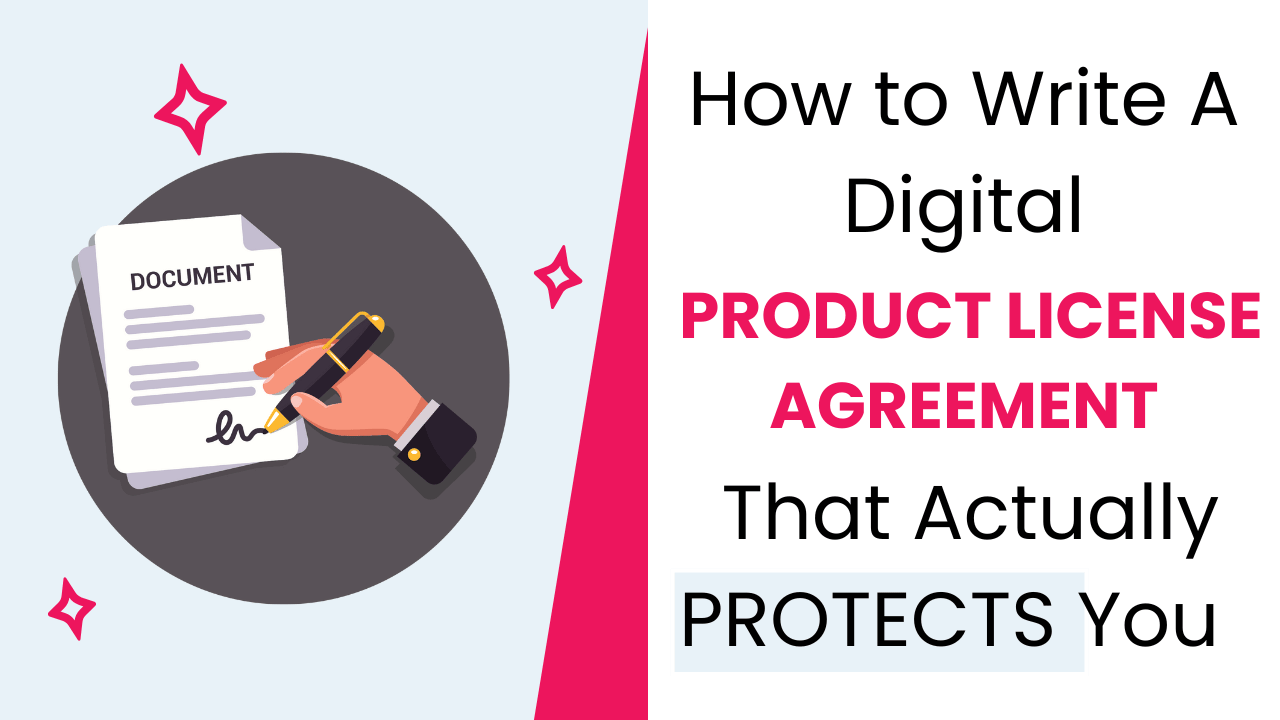How to Write a Digital Product License Agreement That Actually Protects You
Disclaimer: This blog post is for informational purposes only and does not constitute legal advice. I am not a lawyer. Please consult a qualified attorney to ensure your license terms are appropriate for your products and legally compliant in your location.
When you sell digital products like templates, printables, eBooks, or swipe files, you’re not just selling a file. You’re selling permission to use that file in a specific way.
That’s what a license agreement does — it explains what your customers can and can’t do with your product. Without one, your buyers might assume they can resell, copy, or reuse your content however they want.
And that can turn into a big legal headache.
In this post, we’ll walk through how to write a digital product license agreement that protects your business, sets clear expectations, and avoids misuse of your content — without sounding like a law firm.
What Is a Digital Product License?
A digital product license is a short document (or even a section inside your product or website) that explains the terms of use for your product.
It answers questions like:
Can someone use this in their business?
Can they modify it?
Can they resell or give it away?
Think of it as your product’s boundaries. It tells buyers what’s allowed, what’s not, and what happens if they break the rules.
Why You Need a License Agreement
Even if your product is small or low-cost, a license agreement protects you in three big ways:
It prevents confusion about how the product can be used
It protects your intellectual property from being resold or misused
It supports you during disputes or chargebacks if someone claims they didn’t know the rules
Without it, you’re relying on people to just “do the right thing.” And as your business grows, that’s a risky strategy.
Common License Types for Digital Products
Here are the most popular license types used by digital product creators:
1. Personal Use Only
The buyer can use the product for their own personal projects
They cannot use it in their business, share it, or resell it
Example: A printable planner someone downloads and uses at home, but cannot sell or give away.
2. Commercial Use (Non-Editable)
The buyer can use the finished product in their business
They cannot resell, edit, or redistribute the original file
Example: A done-for-you lead magnet they can use with their audience, but can’t change or brand as their own.
3. Commercial Use (Editable/White Label)
The buyer can customize, brand, and even resell the product
Often comes with a higher price and stricter usage terms
Example: Canva templates with permission to rebrand and resell inside a client project or coaching program.
Each of these requires clear boundaries — and that's where your license agreement comes in.
What to Include in a Digital Product License Agreement
Here’s a simple structure you can follow. You don’t need legal jargon — just plain language that covers the key areas.
1. Who the license applies to
“This license is for one individual or business only. Sharing the files or giving access to others is not permitted.”
2. What’s allowed
“You may use this product for your own personal or business use.”
3. What’s not allowed
“You may not resell, redistribute, or give away the original files.”
“You may not claim this product as your own work.”
4. Modification rules (if any)
“You may customize this product for personal use but may not modify and resell it.”
5. Attribution (if required)
“If used commercially, please include credit to [Your Name or Business] with a link to [your website].”
6. Consequences for violating terms
“Violating these terms may result in loss of access and legal action.”
Where to Display Your License Terms
To make your license agreement effective, it must be visible. Here’s where to include it:
Inside your product download (as a PDF or on a separate page)
On your product sales page or description
In your terms of service
On the checkout page, using a checkbox for agreement
In your welcome or delivery email
If you use platforms like ThriveCart, Kajabi, or Etsy, you can upload or link your license terms directly in the checkout flow.
How to Handle Violations
Even with a clear license, some customers will test boundaries. Here’s how to handle it professionally:
Send a friendly reminder of your license terms with a link to the original agreement
Request removal of unauthorized copies or resale listings
Submit a DMCA takedown if your content is published without permission
Consult a legal professional if the issue escalates or results in lost revenue
Keeping a paper trail of your terms and purchases helps you protect your rights if needed.
Final Thoughts
A digital product license agreement doesn’t need to be complicated, but it does need to be clear. By taking time to write one that matches your product type and intended use, you’ll:
Reduce refunds and confusion
Protect your content from unauthorized use
Set boundaries that help you scale with confidence
Whether you’re selling a $9 Canva template or a full course bundle, having a license in place is one of the simplest ways to make your digital business more professional and more protected.




